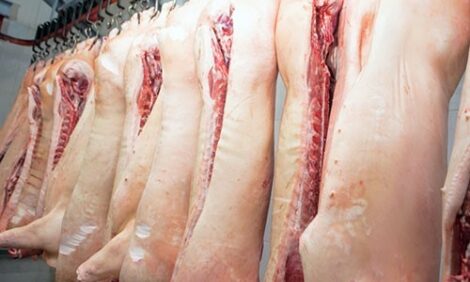



Water monitoring stems flow of health problems
US - The value of monitoring water consumption as a means of controlling disease has been demonstrated dramatically by a large-scale pig farming operation in America. The task has enabled an Iowa company to save over $19,800 ( 311,000) a year through lowered mortality, reduced medication costs, and improved performance.
![]() Four years ago Juergen's Produce and Feed, who produce over 100,000 pigs a year - including 60,000 from their own herd of 3,000 sows - installed 'Barn Report' a computer program from British company Farmex. This monitors and records key production inputs, including temperature, feed and water consumption, from sensors within the piggery.
Four years ago Juergen's Produce and Feed, who produce over 100,000 pigs a year - including 60,000 from their own herd of 3,000 sows - installed 'Barn Report' a computer program from British company Farmex. This monitors and records key production inputs, including temperature, feed and water consumption, from sensors within the piggery.
The production manager, Steve Huegerich, noticed that when an outbreak of swine flu - a common problem within the US pig industry - occurred in their finishing houses, the amount of water drunk tended to fall. This led them to check carefully and analyse historical data from the reports. It was found that water consumption consistently fell by 10-20 per cent in advance of clinical signs of the disease appearing among the pigs.
 Through Farmex's monitoring system, Steve Huegerich, noticed that a dip in pigs' water consumption signals a heath problem is on its way, enabling him to treat it 'in advance' saving thousands of dollars. |
Typically, the company experiences about six outbreaks of swine flu a year in its system of 1,200-pig finishing houses. The policy of early intervention, however, has proved highly successful.
Mortality levels have been reduced by two per cent. This represents an additional 144 pigs marketed a year, worth $17,280 ( 39,600) or $0.29 (16p) per pig produced. The saving on medication, normally two days, at $120 ( 366) per day, is worth a further $1,400 ( 3777) a year. In addition, Steve believes he avoids another 11/2 cents per pig on injectable medication and labour saved through not injecting and hauling dead pigs - a total of nearly $20,000 ( 311,000).
"These figures only represent the cash benefits of catching the flu outbreaks and do not take into account the savings on such items as feed and heating - or the peace of mind the system has given us," he said.
For further information contact:
| Hugh Crabtree 01189 867252 Farmex |
Martin Looker 01473 823842 (BHR Communications) |
Source: BHR communications on behalf of FarmEx - 23rd July 2004








